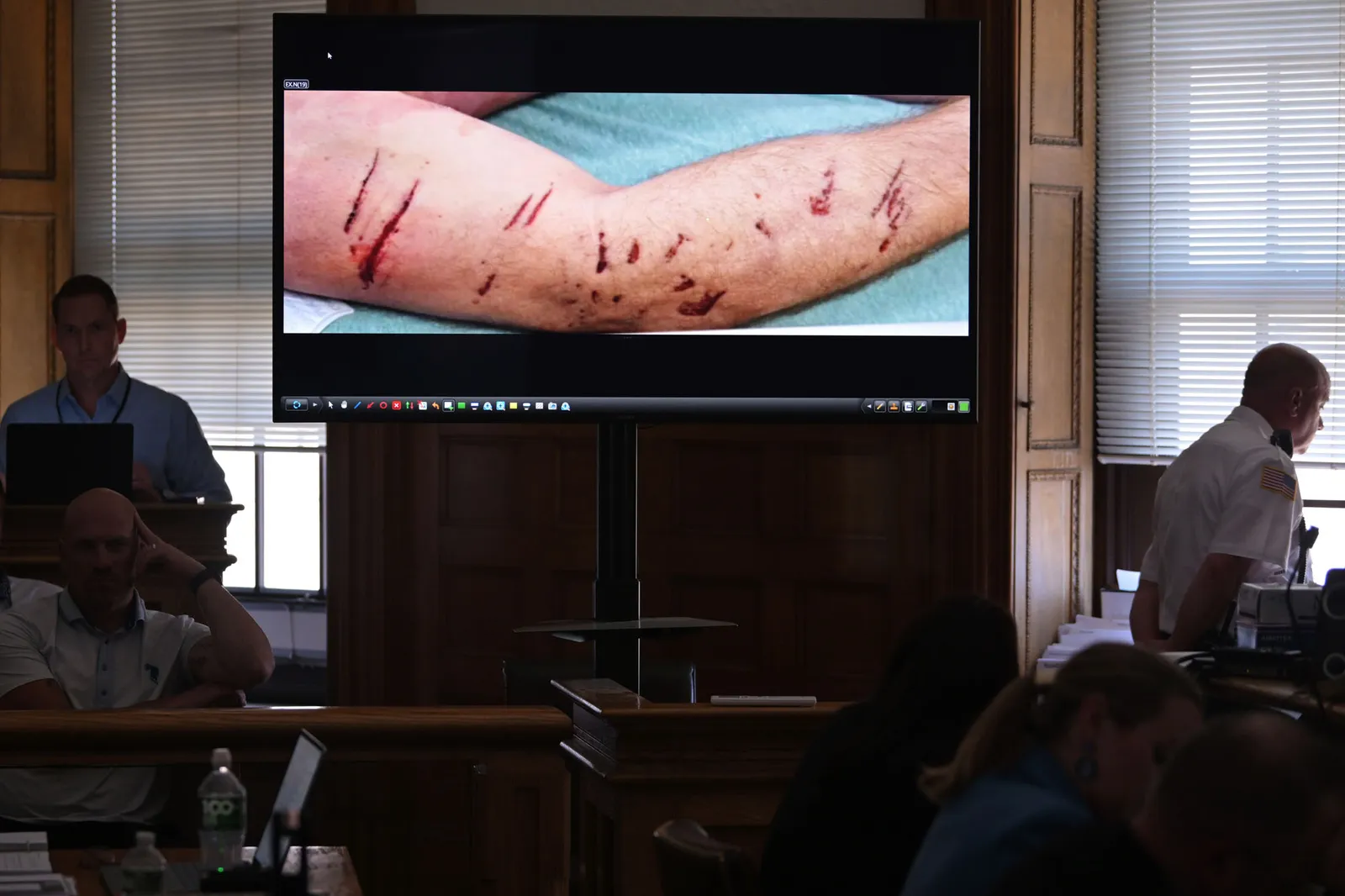In January 2022, a tragic event in Canton, Massachusetts, led to the death of Boston Police Officer John O’Keefe. His girlfriend, Karen Read, was subsequently charged with his murder, sparking a complex legal battle that has captured national attention. This article delves into the intricate details of the case, exploring the events leading up to O’Keefe’s death, the ensuing investigations, and the legal proceedings that have unfolded.
The Night of the Incident
On the evening of January 28, 2022, Karen Read and John O’Keefe visited the Waterfall Bar in Canton, Massachusetts. The couple spent the night socializing and consuming alcohol with friends. Later that night, Read drove O’Keefe to the residence of Brian Albert, a fellow Boston Police Officer, for an after-party. According to Read, she dropped O’Keefe off around 12:20 a.m. and returned home. The following morning, O’Keefe was found unresponsive outside the Albert residence, covered in snow, and was later pronounced dead.
Discovery of John O’Keefe’s Body
In the early hours of January 29, 2022, John O’Keefe was discovered lying in the snow outside the home of Brian Albert. He exhibited signs of hypothermia and had visible injuries, including head trauma. Emergency responders transported him to a local hospital, where he was pronounced dead. The initial assessment suggested that exposure to the cold and blunt force injuries contributed to his death.
Initial Investigation and Charges
The investigation quickly focused on Karen Read. Authorities alleged that she struck O’Keefe with her SUV, causing his injuries, and left him outside in freezing conditions. On February 1, 2022, Read was arrested and charged with manslaughter while operating under the influence of alcohol and leaving the scene of a collision causing death. In June 2022, a grand jury indicted her on an additional charge of second-degree murder. Read pleaded not guilty to all charges.
Defense’s Counterarguments
Karen Read’s defense team has consistently argued that she is being framed and that the investigation was marred by misconduct. They contend that O’Keefe was involved in an altercation inside the Albert residence and was later left outside, leading to his death. The defense has highlighted several points to support their claims:
-
Incomplete Investigation: The defense asserts that authorities failed to thoroughly investigate other individuals present at the Albert residence that night.
-
Evidence Handling: Concerns have been raised about the collection and preservation of evidence, including the alleged mishandling of Read’s vehicle and potential contamination of the crime scene.
-
Bias in Investigation: The lead investigator, Trooper Michael Proctor, was found to have sent inappropriate and biased text messages regarding Read, referring to her in derogatory terms and expressing a predetermined belief in her guilt.
Prosecution’s Stance
The prosecution maintains that Read is responsible for O’Keefe’s death. They argue that she struck him with her vehicle, either knowingly or unknowingly, and left him to succumb to his injuries in the cold. Key points from the prosecution include
-
Vehicle Damage: Damage to Read’s SUV, including a broken taillight, is consistent with striking a person.
-
Statements by Read: Witnesses reported that Read made incriminating statements, such as repeatedly asking if she had hit O’Keefe.
-
Forensic Evidence: The prosecution asserts that forensic evidence supports the theory that O’Keefe was struck by a vehicle.
First Trial and Mistrial
The first trial commenced in May 2024 and lasted nine weeks, featuring testimony from over 65 witnesses. In July 2024, the trial concluded with a hung jury, leading the judge to declare a mistrial. The inability to reach a unanimous verdict underscored the complexities and contentious nature of the case.The US Sun
Developments Leading to Retrial
Following the mistrial, several developments occurred:
Defense Team Augmentation
Karen Read’s defense team welcomed Victoria George, a civil attorney who had served as an alternate juror in the initial trial. Disillusioned by aspects of the first trial, George joined the defense to ensure a fair retrial.
Supreme Court Petition
Read’s legal team petitioned the U.S. Supreme Court to dismiss the charges of second-degree murder and leaving the scene, citing double jeopardy concerns. They argued that jurors in the first trial had effectively acquitted Read on these charges, making a retrial unconstitutional.
Supreme Court Decision
On April 9, 2025, the Supreme Court denied Read’s emergency request to delay her retrial, allowing jury selection to proceed.
Jury Selection for Retrial
Jury selection for the retrial began in early April 2025. As of April 9, 15 jurors had been seated, with one more needed to complete the panel. The court aims to have a diverse and impartial jury to ensure a fair trial.
Contentious Evidence and Points of Dispute
Several pieces of evidence have been points of contention between the prosecution and defense:
-
SUV Damage: The broken taillight on Read’s vehicle is a focal point, with debates over whether it resulted from striking O’Keefe or another incident.
Forensic Analysis: Discrepancies in forensic interpretations, including the nature of O’Keefe’s injuries and the presence of debris, have been heavily debated.
Conflicting Witness Testimonies
One of the most striking elements of the case has been the conflicting accounts provided by witnesses.
The Snowplow Driver’s Testimony
A snowplow driver testified that he did not see a body outside the Albert residence when he passed by around 2:45 a.m., despite having a high vantage point and powerful lights. He claimed he saw a Ford Edge—matching Brian Albert’s vehicle—parked outside the home around 3:15 a.m., an unusual sight since the Alberts rarely parked on the street. He didn’t report the car as a courtesy to the family, whom he had known for years. The defense argued that this supports their theory that O’Keefe’s body was moved after his death.
The prosecution challenged this account by presenting a different timeline, suggesting inconsistencies in the witness’s memory or reliability.
Testimonies from Inside the Albert Home
Witnesses who were allegedly inside the Albert home that night have denied that O’Keefe ever entered. However, the defense points to his Apple Health data, which recorded him taking about 80 steps—roughly half the length of a football field—and climbing or descending three floors shortly after being dropped off. This data conflicts with the claim that he remained outside the house the entire time.
Role of Chloe, the German Shepherd
The defense also introduced the possibility that the Alberts’ German shepherd, Chloe, may have played a role in the night’s events. Chloe was kept in the basement due to her aggressive tendencies with strangers and other animals. A neighbor once recounted an incident in which the dog attacked her goldendoodle with such force that it couldn’t be stopped without intervention. The defense speculated that if O’Keefe entered the home, he could have been attacked by the dog before a potential altercation with the people inside.
Digital Trail and Surveillance Questions
Karen Read’s defense also explored questions around surveillance footage. There were reports that certain cameras in the neighborhood or in proximity to the Albert residence may have either been disabled, failed to record, or were not collected by investigators. The implication is that vital visual evidence may have been overlooked or intentionally disregarded—furthering the defense’s narrative of a biased investigation.
Additionally, the discovery that Read had purchased burner phones and SIM cards, allegedly after learning she was being surveilled, was presented by prosecutors as evidence of suspicious behavior. The defense argued this was a rational response for a woman fearing wrongful arrest in a politically charged environment.
Relationship History and Emotional Motives
Karen Read and John O’Keefe had reconnected during the early days of the COVID-19 pandemic, years after a brief romance in their twenties. Their renewed relationship had ups and downs. The prosecution highlighted alleged tension and an argument the night of the incident. O’Keefe’s niece and nephew testified about relationship strain and a supposed breakup conversation that evening.
Read, on the other hand, shared that their relationship was deep and emotional—both having endured serious personal losses and health crises. She has Crohn’s disease and multiple sclerosis, requiring ongoing treatment. O’Keefe had become the guardian to his niece and nephew after his sister Kristen died from brain cancer and her husband died shortly after from a heart attack. This complex emotional backdrop added another layer of speculation about the night’s dynamics.

Public and Media Reaction
The Karen Read case has become a lightning rod in Massachusetts and beyond, with both supporters and detractors weighing in across social media, true-crime podcasts, and news coverage.
Support for Karen Read
Supporters of Read argue she is being railroaded by a corrupt and insular law enforcement culture. They point to the text messages from Trooper Michael Proctor—calling her a “whack job” and commenting about her phone contents—as evidence of gendered bias and misconduct. These messages were shared during trial, igniting widespread condemnation.
Many believe Read is a scapegoat in a system protecting its own, and her treatment reflects broader systemic issues with police accountability and prosecutorial overreach.
Criticism and Skepticism
On the other side, some members of the public remain convinced of Read’s guilt, citing her intoxication that night, the damage to her SUV, and her reported panicked statements the morning O’Keefe was found. For these critics, the theory that she hit O’Keefe while making a three-point turn in snowy conditions is not far-fetched.
Both sides have staged rallies, fueled social media debates, and dissected each update with the fervor typically reserved for high-profile celebrity trials.
Legal and Societal Implications
The Karen Read case raises significant questions that go far beyond this one tragic event.
Police Transparency and Accountability
Perhaps most prominent is the question of how law enforcement handles internal investigations. When key players in a murder case include multiple police officers from the same tight-knit community, suspicions of bias naturally arise. The defense has suggested that Read is the only person facing scrutiny because others involved are shielded by institutional loyalty.
Trooper Proctor’s behavior has further eroded confidence in the investigative process. His derogatory texts—widely viewed as misogynistic and prejudicial—have fueled calls for reform and oversight in how cases involving law enforcement are handled.

Forensic Interpretation and Modern Evidence
The case also underscores the complexities of using digital data like Apple Health readings and vehicle telemetry in court. These new forms of evidence open fresh avenues for both proving and disputing narratives but also present challenges in interpretation, reliability, and admissibility.
The taillight damage debate is another example of how physical evidence can be interpreted in drastically different ways, depending on the expert and the agenda.
What Happens Next
Karen Read’s retrial is now underway, with jury selection nearly complete and opening statements expected in the coming days. The outcome of this case could have profound effects on public trust in Massachusetts law enforcement and the broader criminal justice system.
If Read is convicted, it may close one chapter of a long and painful saga for the O’Keefe family. But it will also deepen a bitter divide among those who believe Read was unfairly targeted.
If she is acquitted, it could unleash a wave of backlash against the prosecutors, investigators, and even the judicial system at large. Calls for deeper investigations into the Albert household, the Canton police department, and the Massachusetts State Police could follow.
Conclusion
The Karen Read case isn’t just about one woman or one tragic night—it’s about the intersection of justice, power, gender, and institutional loyalty. It’s about how we investigate crimes when the suspects wear badges, and whether our systems are strong enough to pursue the truth without fear or favor.
As this retrial unfolds, the public will be watching not only to see what verdict is delivered—but to determine whether justice in Massachusetts is still worthy of its name.
- Bonnie Blue secretly filming huge C4 show which will reveal ‘what her life’s really like’ after 1,000 men sex stunt - June 5, 2025
- When is Mother’s Day 2025 in the UK? Origins and global celebration dates - June 5, 2025
- Who is Dave Blunts? The ghostwriter rapper behind Kanye West’s new album - June 5, 2025








